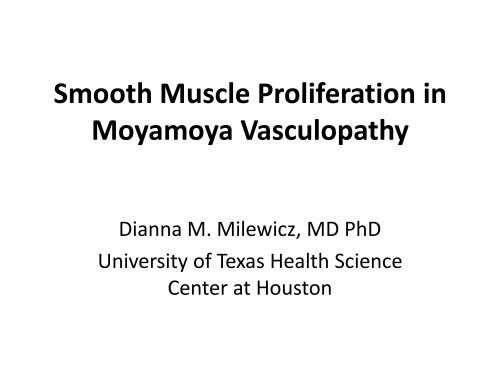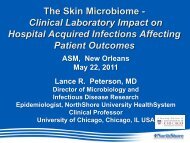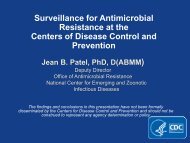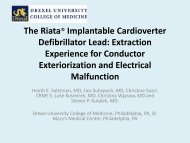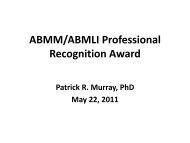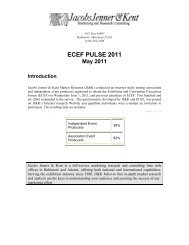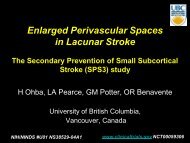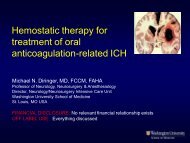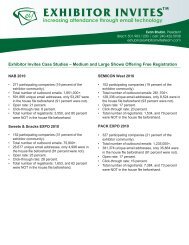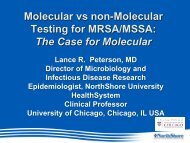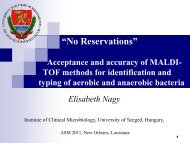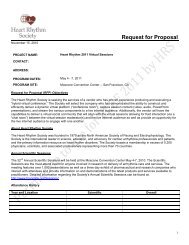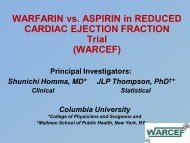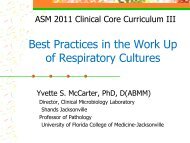Smooth Muscle Proliferation in Moyamoya Vasculopathy
Smooth Muscle Proliferation in Moyamoya Vasculopathy
Smooth Muscle Proliferation in Moyamoya Vasculopathy
You also want an ePaper? Increase the reach of your titles
YUMPU automatically turns print PDFs into web optimized ePapers that Google loves.
<strong>Smooth</strong> <strong>Muscle</strong> <strong>Proliferation</strong> <strong>in</strong><br />
<strong>Moyamoya</strong> <strong>Vasculopathy</strong><br />
Dianna M. Milewicz, MD PhD<br />
University of Texas Health Science<br />
Center at Houston
<strong>Moyamoya</strong> Disease<br />
• Ischemic strokes due to stenosis of the <strong>in</strong>tracranial <strong>in</strong>ternal<br />
carotid arteries and their proximal branches associated with<br />
the formation of collaterals<br />
• Increased <strong>in</strong> prevalence <strong>in</strong> Japan<br />
– RNF213 mutations<br />
• Familial <strong>in</strong> 8% of patients<br />
genetic predisposition<br />
• MMD and genetic syndromes:<br />
– Neurofibromatosis<br />
– Noonan syndrome<br />
– Sickle cell anemia<br />
genetic heterogeneity
Cerebrovascular Pathology Associated<br />
with <strong>Moyamoya</strong> Disease<br />
Occlusion of the artery<br />
Neo<strong>in</strong>timal lesions with<br />
smooth muscle cells<br />
No lipid deposition or<br />
<strong>in</strong>flammation<br />
Do genetic mutations that <strong>in</strong>crease SMC<br />
proliferation play a role <strong>in</strong> the pathogenesis of<br />
<strong>Moyamoya</strong> disease?
ACTA2 Missense Mutations Cause Familial<br />
Thoracic Aortic Aneurysms and Dissections<br />
ACTA2 R149C missense mutation<br />
Penetrance of TAAD: 50%
Aortic <strong>Smooth</strong> <strong>Muscle</strong> Cells and<br />
Aortic Media<br />
the Contractile Unit<br />
Act<strong>in</strong><br />
Contractile Unit<br />
Myos<strong>in</strong>
ACTA2 Missense Mutations <strong>in</strong> FTAAD<br />
G48V<br />
P72Q<br />
N117T R149C<br />
Forty ACTA2 missense mutations<br />
No polymorphic variants <strong>in</strong> controls<br />
All mutations mutant prote<strong>in</strong><br />
R179H<br />
1 2 3 4 5 6 7 8 9<br />
R39C R39H R118Q Y135H G160D R212Q<br />
L69Q<br />
W88R<br />
V154A<br />
R258H R258C<br />
G270R<br />
R292G<br />
T353N
ACTA2 Mutations Cause Livedo Reticularis:<br />
Sk<strong>in</strong> Rash Due to Arterial Occlusion<br />
Penetrance of livedo reticularis is 100%
Aortic Arterial Pathology <strong>in</strong> Patients<br />
with ACTA2 Mutations<br />
Control ACTA2 R149C ACTA2 R149C ACTA2 T353N<br />
ACTA2 Sta<strong>in</strong><strong>in</strong>g<br />
100X
ACTA2 Mutations Lead to Early Onset<br />
Coronary Artery Disease<br />
TAAD<br />
Premature CAD<br />
Premature stroke
<strong>Moyamoya</strong> Disease and<br />
Early Onset Strokes <strong>in</strong><br />
ACTA2 Mutation Carriers<br />
TAAD<br />
Premature CAD<br />
Premature stroke
De Novo ACTA2 R179H Mutations<br />
<strong>Smooth</strong> <strong>Muscle</strong> Dysfunction Syndrome<br />
• 15 patients with de novo ACTA2 R179H<br />
• Fully penetrant vascular diseases at young ages:<br />
– Ascend<strong>in</strong>g aortic aneurysms<br />
– <strong>Moyamoya</strong> disease<br />
– PDA<br />
• Loss of SMC function <strong>in</strong> other organs:<br />
– Fixed dilated pupils<br />
– Hypotonic bladder<br />
– Hypoperistalsis with malrotation<br />
– Patent ductus arteriosus<br />
• Proliferative SMC phenotypes:<br />
– Aortic coarctation<br />
– Primary pulmonary hypertension
Loss of function:<br />
Decreased SMC<br />
contraction<br />
Large arteries:<br />
-high elast<strong>in</strong> content<br />
- Exposed to high<br />
pressures<br />
Aortic<br />
Aneurysms<br />
ACTA2 <strong>Vasculopathy</strong><br />
Ga<strong>in</strong> of function:<br />
Increased SMC<br />
proliferation<br />
Small arteries:<br />
-low elast<strong>in</strong> content<br />
-exposed to low<br />
pressures<br />
Vascular occlusive diseases<br />
(CAD, stroke)
Characterization of Mouse Model:<br />
Acta2 -/- Mice<br />
Fold change (a.u.)<br />
1.4<br />
1.2<br />
1<br />
0.8<br />
0.6<br />
0.4<br />
0.2<br />
0<br />
Acta2 expression<br />
Wt<br />
Acta2 mRNA<br />
α-act<strong>in</strong><br />
GAPDH<br />
Acta2 -/-<br />
Previously characterized by Schildmeyer et al<br />
(2000):<br />
Contractility of arteries<br />
Blood pressure<br />
Schildmeyer LA et al (2000). FASEB J.
Acta2 -/- SMCs Proliferate and Migrate<br />
Faster than Wild-type SMCs<br />
<strong>Proliferation</strong> – ascend<strong>in</strong>g SMCs <strong>Proliferation</strong> – descend<strong>in</strong>g SMCs<br />
BrdU <strong>in</strong>corporation (OD)<br />
1<br />
0.8<br />
0.6<br />
0.4<br />
0.2<br />
0<br />
p
Acta2 -/- Mice: Increased<br />
Neo<strong>in</strong>timal <strong>Proliferation</strong> with Vascular Injury<br />
ligation site<br />
Neo<strong>in</strong>tima Area (µm 2 )<br />
40000<br />
30000<br />
20000<br />
10000<br />
0<br />
Injury<br />
wildtype Acta2-/-<br />
p < 0.01<br />
p < 0.01<br />
- + - +<br />
WT Acta2-/-<br />
% Stenosis<br />
100<br />
80<br />
60<br />
40<br />
20<br />
0<br />
Injury<br />
p < 0.01<br />
+ +<br />
WT Acta2-/-
BrdU <strong>in</strong>corporation (OD)<br />
Anti-cancer Drug Decreases <strong>Proliferation</strong><br />
<strong>in</strong> vitro and Neo<strong>in</strong>timal Formation <strong>in</strong> vivo<br />
1.4<br />
1.2<br />
1<br />
0.8<br />
0.6<br />
0.4<br />
0.2<br />
0<br />
p
Loss of function:<br />
Decreased SMC<br />
contraction<br />
Large arteries:<br />
-high elast<strong>in</strong> content<br />
- Exposed to high<br />
pressures<br />
Aortic<br />
Aneurysms<br />
ACTA2 <strong>Vasculopathy</strong><br />
Ga<strong>in</strong> of function:<br />
Increased SMC<br />
proliferation<br />
Small arteries:<br />
-low elast<strong>in</strong> content<br />
-exposed to low<br />
pressures<br />
Vascular occlusive diseases<br />
(CAD, stroke)
<strong>Vasculopathy</strong> Associated with Neurofibromatosis<br />
• Affects aorta to small arterioles<br />
• Can cause aneurysms and occlusive diseases, <strong>in</strong>clud<strong>in</strong>g<br />
<strong>Moyamoya</strong> disease<br />
• Mouse studies show <strong>in</strong>creased SMC proliferation and<br />
migration and <strong>in</strong>crease neo<strong>in</strong>timal formation<br />
• NF1 mutations
<strong>Moyamoya</strong> disease and RNF213 Mutations<br />
• Identified through l<strong>in</strong>kage analysis and<br />
association studies as a gene that causes<br />
MMD <strong>in</strong> Japan.<br />
• “Founder” mutation <strong>in</strong> Japan (Asia?).<br />
• Function of the gene is unknown.<br />
• 10 – 15% of MMD patients <strong>in</strong> our U.S. cohort<br />
have RNF213 mutations (unpublished data).
Conclusions<br />
• A subset of ACTA2 mutations predispose to MMD.<br />
• Acta2 deficient mouse models suggest that<br />
occlusive disease is driven by SMC hyperplasia.<br />
– Why do some mutations cause more SMC hyperplasia?<br />
• Anti-cancer drug may prevent or limit MMD lesions<br />
<strong>in</strong> patients with ACTA2 mutations.<br />
– Can anti-proliferative drugs used to treat MMD?<br />
• NF1 mouse model also suggests that occlusive<br />
disease is due to SMC hyperplasia.<br />
• RNF213 is a major gene for MMD.<br />
– Do RNF213 mutations cause SMC hyperplasia?
Milewicz Lab members<br />
Ellen Regalado<br />
Dongchuan Guo, Ph.D.<br />
Christ<strong>in</strong>a Papke, Ph.D.<br />
Jiumei Cao, Ph.D.<br />
Stanford School of Medic<strong>in</strong>e<br />
Gary Ste<strong>in</strong>berg, MD PhD<br />
MD Anderson Cancer Center<br />
Aarif Khakoo, M.D.<br />
Meredith Rees<br />
Texas A&M<br />
Warren Zimmer, Ph.D.<br />
Soon-Mi Lim, Ph.D.<br />
Andreea Trache, Ph.D.<br />
University of Geneva<br />
Giulio Gabbiani, Ph.D.<br />
Christ<strong>in</strong>e Chaponnier, Ph.D.<br />
Acknowledgements<br />
Fund<strong>in</strong>g<br />
NIH P50HL083794-01<br />
NIH R01HL034786<br />
Vivian L. Smith Foundation


